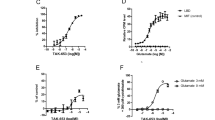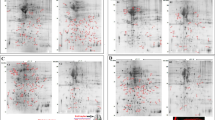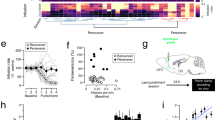Abstract
Activation of α-amino-3-hydroxy-5-methyl-4-isoxazole-propionic acid receptor (AMPA-R) is a promising strategy to treat psychiatric and neurological diseases if issues of bell-shaped response and narrow safety margin against seizure can be overcome. Here, we show that structural interference at Ser743 in AMPA-R is a key to lower the agonistic effect of AMPA-R potentiators containing dihydropyridothiadiazine 2,2-dioxides skeleton. With this structural insight, TAK-137, 9-(4-phenoxyphenyl)-3,4-dihydropyrido[2,1-c][1,2,4]thiadiazine 2,2-dioxide, was discovered as a novel AMPA-R potentiator with a lower agonistic effect than an AMPA-R potentiator LY451646 ((R)-N-(2-(4′-cyanobiphenyl-4-yl)propyl)propane-2-sulfonamide) in rat primary neurons. TAK-137 induced brain-derived neurotrophic factor in neurons in rodents and potently improved cognition in both rats and monkeys. Compared to LY451646, TAK-137 had a wider safety margin against seizure in rats. TAK-137 enhanced neural progenitor proliferation over a broader range of doses in rodents. Thus, TAK-137 is a promising AMPA-R potentiator with potent procognitive effects and lower risks of bell-shaped response and seizure. These data may open the door for the development of AMPA-R potentiators as therapeutic drugs for psychiatric and neurological diseases.
Similar content being viewed by others
Log in or create a free account to read this content
Gain free access to this article, as well as selected content from this journal and more on nature.com
or
References
Ozawa S, Kamiya H, Tsuzuki K. Glutamate receptors in the mammalian central nervous system. Prog Neurobiol. 1998;54(5):581–618.
Keinanen K, Wisden W, Sommer B, Werner P, Herb A, Verdoorn TA, et al. A family of AMPA-selective glutamate receptors. Science. 1990;249(4968):556–560.
Nakanishi N, Shneider NA, Axel R. A family of glutamate receptor genes: evidence for the formation of heteromultimeric receptors with distinct channel properties. Neuron. 1990;5(5):569–581.
Sommer B, Keinanen K, Verdoorn TA, Wisden W, Burnashev N, Herb A, et al. Flip and flop: a cell-specific functional switch in glutamate-operated channels of the CNS. Science. 1990;249(4976):1580–1585.
Boulter J, Hollmann M, O’Shea-Greenfield A, Hartley M, Deneris E, Maron C, et al. Molecular cloning and functional expression of glutamate receptor subunit genes. Science. 1990;249(4972):1033–1037.
Fletcher EJ, Nutt SL, Hoo KH, Elliott CE, Korczak B, McWhinnie EA, et al. Cloning, expression and pharmacological characterization of a human glutamate receptor: hGluR4. Recept Channels. 1995;3(1):21–31.
Kato AS, Siuda ER, Nisenbaum ES, Bredt DS. AMPA receptor subunit-specific regulation by a distinct family of type II TARPs. Neuron. 2008;59(6):986–996.
Schoft VK, Schopoff S, Jantsch MF. Regulation of glutamate receptor B pre-mRNA splicing by RNA editing. Nucleic Acids Res. 2007;35(11):3723–3732.
Tomita S. Regulation of ionotropic glutamate receptors by their auxiliary subunits. Physiology (Bethesda). 2010;25(1):41–49.
Derkach VA, Oh MC, Guire ES, Soderling TR. Regulatory mechanisms of AMPA receptors in synaptic plasticity. Nat Rev Neurosci. 2007;8(2):101–113.
O’Neill MJ, Dix S. AMPA receptor potentiators as cognitive enhancers. IDrugs. 2007;10(3):185–192.
Shaffer CL, Hurst RS, Scialis RJ, Osgood SM, Bryce DK, Hoffmann WE, et al. Positive allosteric modulation of AMPA receptors from efficacy to toxicity: the interspecies exposure-response continuum of the novel potentiator PF-4778574. J Pharmacol Exp Ther. 2013;347(1):212–224.
Duman RS, Li N, Liu RJ, Duric V, Aghajanian G. Signaling pathways underlying the rapid antidepressant actions of ketamine. Neuropharmacology. 2012;62(1):35–41.
Beattie EC, Carroll RC, Yu X, Morishita W, Yasuda H, von Zastrow M, et al. Regulation of AMPA receptor endocytosis by a signaling mechanism shared with LTD. Nat Neurosci. 2000;3(12):1291–1300.
Yamada KA. Modulating excitatory synaptic neurotransmission: potential treatment for neurological disease? Neurobiol Dis. 1998;5(2):67–80.
Ehlers MD. Reinsertion or degradation of AMPA receptors determined by activity-dependent endocytic sorting. Neuron. 2000;28(2):511–525.
Fowler JH, Whalley K, Murray T, O’Neill MJ, McCulloch J. The AMPA receptor potentiator LY404187 increases cerebral glucose utilization and c-fos expression in the rat. J Cereb Blood Flow Metab. 2004;24(10):1098–1109.
Bai F, Bergeron M, Nelson DL. Chronic AMPA receptor potentiator (LY451646) treatment increases cell proliferation in adult rat hippocampus. Neuropharmacology. 2003;44(8):1013–1021.
Bernard K, Danober L, Thomas JY, Lebrun C, Munoz C, Cordi A, et al. Drug focus: S18986: a positive allosteric modulator of AMPA-type glutamate receptors pharmacological profile of a novel cognitive enhancer. CNS Neurosci Ther. 2010;16(5):e193–212.
Kunugi A, Tajima Y, Kuno H, Sogabe S, Kimura H. HBT1, a novel AMPA receptor potentiator with lower agonistic effect, avoided bell-shaped response in in vitro BDNF production. J Pharmacol Exp Ther. 2018;364(3):377-389.
Hayashi Y, Nihonmatsu-Kikuchi N, Yu X, Ishimoto K, Hisanaga SI, Tatebayashi Y. A novel, rapid, quantitative cell-counting method reveals oligodendroglial reduction in the frontopolar cortex in major depressive disorder. Mol Psychiatry. 2011;16(12):1155–1158.
Shiraishi E, Suzuki K, Harada A, Suzuki N, Kimura H. The phosphodiesterase 10A selective inhibitor TAK-063 improves cognitive functions associated with schizophrenia in rodent models. J Pharmacol Exp Ther. 2016;356(3):587–595.
Traynelis SF, Wollmuth LP, McBain CJ, Menniti FS, Vance KM, Ogden KK, et al. Glutamate receptor ion channels: structure, regulation, and function. Pharmacol Rev. 2010;62(3):405–496.
Kaae BH, Harpsoe K, Kastrup JS, Sanz AC, Pickering DS, Metzler B, et al. Structural proof of a dimeric positive modulator bridging two identical AMPA receptor-binding sites. Chem Biol. 2007;14(11):1294–1303.
Sobolevsky AI, Rosconi MP, Gouaux E. X-ray structure, symmetry and mechanism of an AMPA-subtype glutamate receptor. Nature. 2009;462(7274):745–756.
Ward SE, Bax BD, Harries M. Challenges for and current status of research into positive modulators of AMPA receptors. Br J Pharmacol. 2010;160(2):181–190.
Mackowiak M, O’Neill MJ, Hicks CA, Bleakman D, Skolnick P. An AMPA receptor potentiator modulates hippocampal expression of BDNF: an in vivo study. Neuropharmacology. 2002;43(1):1–10.
Gates M, Ogden A, Bleakman D. Pharmacological effects of AMPA receptor potentiators LY392098 and LY404187 on rat neuronal AMPA receptors in vitro. Neuropharmacology. 2001;40(8):984–991.
Arai AC, Kessler M, Rogers G, Lynch G. Effects of the potent ampakine CX614 on hippocampal and recombinant AMPA receptors: interactions with cyclothiazide and GYKI 52466. Mol Pharmacol. 2000;58(4):802–813.
Miu P, Jarvie KR, Radhakrishnan V, Gates MR, Ogden A, Ornstein PL, et al. Novel AMPA receptor potentiators LY392098 and LY404187: effects on recombinant human AMPA receptors in vitro. Neuropharmacology. 2001;40(8):976–983.
Zarrinmayeh H, Bleakman D, Gates MR, Yu H, Zimmerman DM, Ornstein PL, et al. [3H]N-2-(4-(N-benzamido)phenyl)propyl-2-propanesulfonamide: a novel AMPA receptor potentiator and radioligand. J Med Chem. 2001;44(3):302–304.
Acknowledgements
We wish to express our sincere thanks to Ayumi Fukakusa for supporting the behavior studies, Aki Hirokawa, and Shigeru Igaki for providing recombinant proteins, Lane Weston and Gyorgy Snell for supporting the X-ray crystallography analysis, Shizu Tsukada for supporting the FACS analysis, Takanobu Kuroita, Masakuni Kori, and Takashi Miki for their guidance and kind suggestions on medicinal chemistry, and Masashi Toyofuku and Eiji Honda for SAR study of TAK-137-related compounds.
Author information
Authors and Affiliations
Corresponding author
Ethics declarations
Competing interests
The authors are employees of Takeda Pharmaceutical Company Limited. The authors declare no competing interests.
Additional information
Publisher's note: Springer Nature remains neutral with regard to jurisdictional claims in published maps and institutional affiliations.
Electronic supplementary material
Rights and permissions
About this article
Cite this article
Kunugi, A., Tanaka, M., Suzuki, A. et al. TAK-137, an AMPA-R potentiator with little agonistic effect, has a wide therapeutic window. Neuropsychopharmacol. 44, 961–970 (2019). https://doi.org/10.1038/s41386-018-0213-7
Received:
Revised:
Accepted:
Published:
Issue date:
DOI: https://doi.org/10.1038/s41386-018-0213-7



